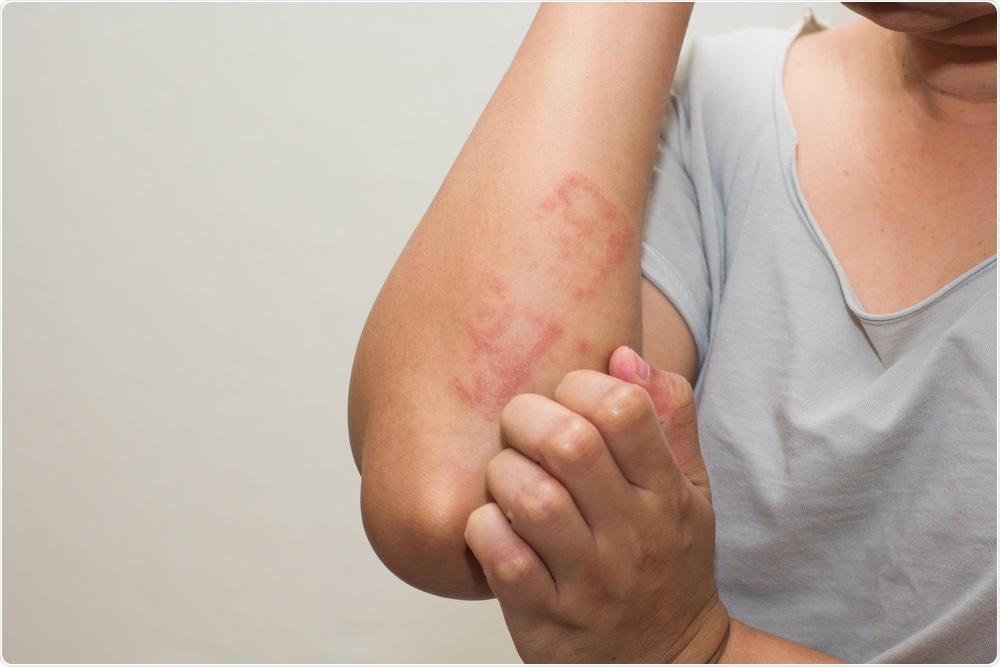A new review published in the journal Canadian Family Physician describes skin diseases caused by the coronavirus disease 2019 (COVID-19).
 Study: The COVID-19 pandemic and its skin effects. Image Credit: pumatokoh / Shutterstock.com
Study: The COVID-19 pandemic and its skin effects. Image Credit: pumatokoh / Shutterstock.com
Background
COVID-19 is caused by the severe acute respiratory syndrome coronavirus 2 (SARS-CoV-2), which is a respiratory pathogen that often causes systemic complications in severe cases.
The current review examines the direct skin features caused by COVID-19, as well as the indirect manifestations associated with mitigation measures such as the use of hand sanitizers and personal protective equipment (PPE). The third cause of skin diseases during this pandemic is the high level of mental and social stress induced by the current situation.
Cutaneous illnesses due to SARS-CoV-2 have been rising worldwide. These diseases typically fall into five different patterns, which include maculopapular rash, vesicular rash, pseudo-chilblain, livedo or necrosis, and urticaria. A red rash and urticaria are considered to be the most common manifestations of COVID-19.
In addition to the aforementioned skin reactions, various researchers have also reported the occurrence of purpuric rashes over the flexural lines, co-infections with herpes zoster virus (HZV), and a multi-system inflammatory syndrome in children that is similar to Kawasaki syndrome.
Overall, about 7% of patients who are positive for COVID-19 have one or more skin symptoms. The wide spectrum of skin disease(s) in this illness is likely caused by variations in the virus itself, differing host factors, as well as co-infection by other viruses like parvovirus and HZV.
Rashes caused by SARS-CoV-2
In one study, at least half of the patients with skin findings had a maculopapular rash. The link between this symptom and COVID-19 appears to be the presence of the virus; however, SARS-CoV-2 is not likely to be the only virus responsible for this reaction.
For these patients, vesicles appeared early in the course of the illness. Additionally, these skin reactions appeared before the onset of other symptoms and mostly occurred in patients with moderately severe disease. The rash appeared on the trunk of patients and consisted of either clear or bloody vesicles.
Pseudo-chilblains are due to the propensity of SARS-CoV-2 to cause vasoconstriction. Herein, the patient presents with ischemia of the extremities, with swollen fingers and toes that often become reddish and painful. In most of these cases, the COVID-19 presentation is milder as compared to that which is observed with vesicular lesions.
Pseudo-chilblains are typically self-limiting and non-scarring lesions that resolve within two weeks. Over 90% of patients were COVID-19-negative, with most being of a younger age.
Like Pseudo-chilblains, livedo reticularis is also likely due to the effects of SARS-CoV-2 on the blood vessels of the skin. This skin condition can also be caused by reduced blood flow that is linked to clots. These lesions are blanching in nature, short-lived, and often unaccompanied by itching. However, livedo reticularis lesions are prone to become necrotic in severe COVID-19, and may thus serve as a biomarker for progressive disease.
Urticaria may precede or accompany other symptoms of COVID-19. These lesions, which have resolved in some cases following the administration of oral antihistamines, typically signify severe disease and are almost always pruritic.
The presence of Kawasaki-like syndrome in children with COVID-19 appears to be a sign of immune activation by the virus that causes vasculitis of medium-sized vessels. These lesions are polymorphic, involve the skin and oral mucosa, and are more severe on the perineum.
Indirect causes of skin diseases
The COVID-19 pandemic has led to many behavioral changes, including the regular and frequent use of hand sanitizers or soap. As a result, many have reported hand dermatitis. Healthcare workers and others using PPE have also complained of pressure injuries from mask and goggle use, dermatitis of facial skin, xerosis, and worsening of already existing skin illnesses.
It is noteworthy that the use of emollients after hand sanitization may prevent this, as may the use of gloves and masks that fit properly.
Psychosocial stress-induced aggravation of skin conditions
People who are in high stress environments, particularly frontline workers, as well as those who have endured long periods of social restriction due to the pandemic, are at risk for worsening of cutaneous diseases like baldness, chronic urticaria, atopic dermatitis like eczema, and psoriasis. Unfortunately, the mechanism by which these conditions are worsening remains unknown, however.
Immunomodulatory medications are necessary in treating COVID-19; however, if suddenly stopped, rebound exacerbations may occur. Patients with chronic skin disease who develop COVID-19 should be closely monitored in order to identify disease progression or worsening.
Implications
Patients with COVID-19 are liable to primary or secondary skin illness, which could be caused by the viral infection, by adverse reactions to the drugs used to treat the illness, coinfections, or because of mitigation measures. Psychosocial stress as a result of COVID-19, pandemic restrictions, and/or the risk of illness, can also precipitate or worsen these cutaneous lesions. Pre-existing skin diseases may also undergo aggravation as a result of these COVID-19-related factors.
“Patient education on prevention and further research into dermatologic presentations of SARS-CoV-2 are recommended.”